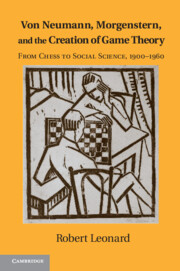Book contents
- Frontmatter
- Contents
- Acknowledgments
- Von Neumann, Morgenstern, and the Creation of Game Theory
- Introduction
- Part One Struggle and Equilibrium: from Lasker to von Neumann
- 1 “The Strangest States of Mind”
- 2 “Deeply Rooted, Yet Alien”
- 3 From Budapest to Göttingen
- 4 “The Futile Search for the Perfect Formula”
- Part Two Oskar Morgenstern and Interwar Vienna
- Part Three From War to Cold War
- Bibliography
- Index
- Plate section
4 - “The Futile Search for the Perfect Formula”
Von Neumann's Minimax Theorem
Published online by Cambridge University Press: 05 December 2013
- Frontmatter
- Contents
- Acknowledgments
- Von Neumann, Morgenstern, and the Creation of Game Theory
- Introduction
- Part One Struggle and Equilibrium: from Lasker to von Neumann
- 1 “The Strangest States of Mind”
- 2 “Deeply Rooted, Yet Alien”
- 3 From Budapest to Göttingen
- 4 “The Futile Search for the Perfect Formula”
- Part Two Oskar Morgenstern and Interwar Vienna
- Part Three From War to Cold War
- Bibliography
- Index
- Plate section
Summary
The Infinite Chessboard
Von Neumann's Hungarian teachers had been long interested in the mathematics of games. In 1905, in the columns of KöMaL, the mathematics magazine, a short paper by one Jószef Weisz entitled “On the Determination of Game Differences”, dealt with a game that was not one of pure chance. Throughout the 1920s, KöMaL founder Daniel Arány published papers examining how the probabilities of winning in games of pure chance varied with the number of players. The Eötvös Competition of 1926, conceived by Dénes König, contained a question concerning the solution to a system of two equations, the answer to which was equivalent to proving that, on an infinite chessboard, any square can be reached by a knight via a sequence of appropriate moves. Like many of his colleagues, von Neumann was a chessplayer. Indeed, one of the first things he and his friend Willy Fellner did upon moving to Zurich in 1925 was to join the Schachgesellschaft Zurich, one of the oldest chess clubs in the world and a landmark in international chess circles. It therefore is easy to understand why, in the mid-1920s, König, Lászlo Kalmár, and von Neumann took an interest in Zermelo's set-theoretic analysis of chess.
Citing discussions with von Neumann, both König and Kalmár sought to refine Zermelo's 1913 paper. In his paper, “On a Method of Conclusion from the Finite to the Infinite”, König (1927) followed von Neumann's suggestion to apply to chess a lemma from set theory in order to prove the conjecture that the number of moves within which a player in a winning position can force a win is finite. In order to do this, König invokes the use of an infinite board, but with the usual thirty-two pieces. He also addresses two respects in which Zermelo's earlier proof was incomplete, the most important of which was that it had not been proved that a player in a winning position was always able to force a win in a number of moves less than the number of positions in the game.
- Type
- Chapter
- Information
- Von Neumann, Morgenstern, and the Creation of Game TheoryFrom Chess to Social Science, 1900–1960, pp. 56 - 74Publisher: Cambridge University PressPrint publication year: 2010

